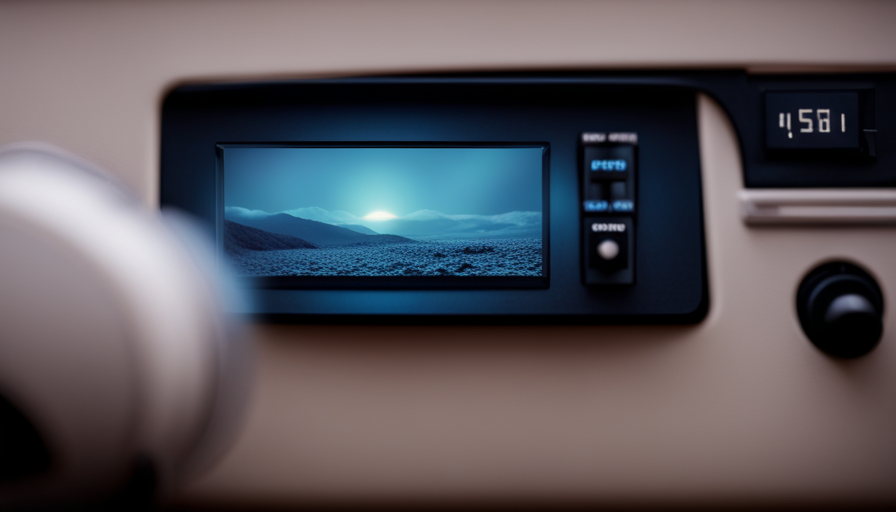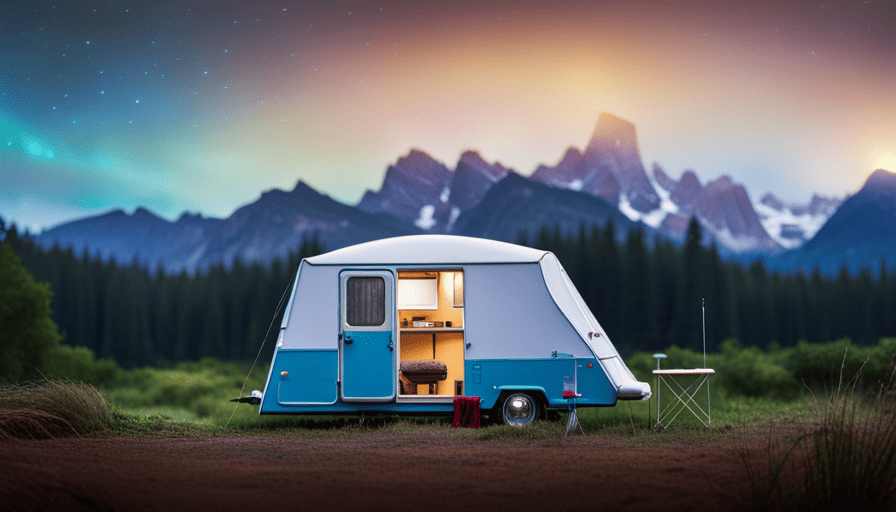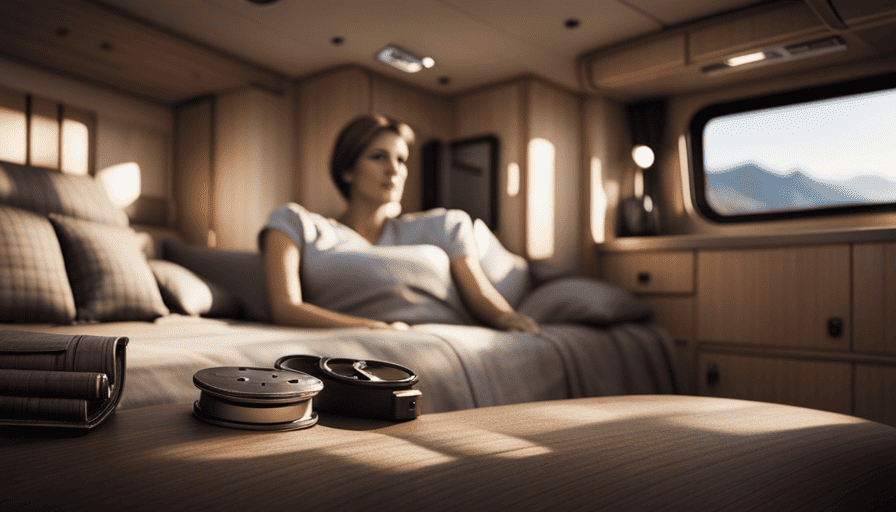Ever wished you could turn a cold camping trip into a snuggle-fest in a warm, comfy camper? Good news, outdoor lovers! This guide cracks the code on firing up your camper’s heater, keeping you warm and cozy, no matter how icy it gets outside.
As we delve into the intricacies of camper heating systems, we will provide you with step-by-step instructions on how to master this essential skill. From familiarizing yourself with the heating system to monitoring carbon monoxide levels, we leave no stone unturned in our quest to keep you warm and comfortable.
But our expertise doesn’t stop there! We will also explore additional heating methods that can supplement your camper’s heating system, ensuring you have a backup plan for those extra chilly nights.
So, let’s embark on this journey together and discover the secrets to turning on the heater in your camper. Get ready to embrace the warmth and make your camping experience unforgettable!
Key Takeaways
- Familiarize yourself with the location and functions of the heater control panel.
- Ensure proper power supply and connection before turning on the heater.
- Set the desired temperature for comfort and adjust the fan speed for efficient heat distribution.
- Maintain proper ventilation for effective heating by utilizing various options for air circulation and avoiding stagnant or cold air.
Familiarize Yourself with Your Camper’s Heating System
Before you start camping, make sure you’re familiar with your camper’s heating system. It’s important to understand how it works and be prepared for any common heating problems that may arise.
One of the most common issues campers face is a heater that doesn’t turn on. If you encounter this problem, there are a few troubleshooting tips you can try before seeking professional help.
First, check the power source. Ensure that your camper is properly connected to a power outlet or that the battery is charged. Sometimes a simple power issue can prevent the heater from turning on.
Next, inspect the thermostat. Make sure it’s set to the desired temperature and functioning correctly. If the thermostat is not working, it may need to be replaced.
Another common problem is a clogged air filter. A dirty air filter can restrict airflow and cause the heater to malfunction. Regularly clean or replace the air filter to prevent this issue.
Additionally, check the fuel supply. If you have a propane heater, make sure the propane tank is not empty. Refill or replace the tank as needed.
Now that you’re familiar with common heating problems and some troubleshooting tips, let’s move on to the next section where we will locate the heater control panel.
Locate the Heater Control Panel
First, find the control panel that’ll keep you nice and toasty inside your cozy home on wheels. The heater control panel is a crucial component of your camper’s heating system. Knowing its location is essential for troubleshooting common heater issues and ensuring the proper functioning of the system.
Here are some key points to consider:
- The control panel is typically located near the main entrance or in a central area of the camper for easy access. It may be labeled as the ‘heater control panel’ or simply as ‘heater controls.’
- Look for a series of switches or buttons that allow you to adjust the temperature, fan speed, and other settings.
- Some control panels also feature a digital display that shows the current temperature and other relevant information.
By familiarizing yourself with the location and functions of the heater control panel, you’ll be able to troubleshoot common heater issues more effectively.
Once you’ve located the control panel, the next step is to turn on the power supply, which we’ll discuss in the subsequent section.
Turn on the Power Supply
To ensure a seamless operation, you’ll want to activate the power supply for your cozy mobile abode. The first step is to locate the power supply switch or button on the heater control panel. This is typically located near the other controls for temperature and fan speed.
Once you have located the power supply switch, press it to turn on the electrical connection to the heater.
Before turning on the power supply, it’s important to ensure that your camper is properly connected to a reliable source of electricity. This can be a campground hookup or a generator. Check that the electrical connection is secure and that there are no loose or frayed wires. Safety should always be a top priority when dealing with electricity.
Once the power supply is activated, you can move on to setting the desired temperature. This will allow you to customize the level of warmth in your camper to your liking. Adjust the temperature control knob or buttons on the heater control panel to your desired setting. This will ensure that your camper stays cozy and comfortable throughout your camping adventure.
Transitioning to the next section, let’s now discuss how to set the desired temperature in more detail.
Set the Desired Temperature
Adjusting the temperature control knob or buttons allows us to create a cozy and comfortable atmosphere inside our mobile abode. To set the thermostat, we need to locate the temperature control panel, which is usually located near the heater unit. Once we’ve found it, we can either turn the knob to the desired temperature or press the buttons to adjust it.
Most campers have a digital display that shows the current temperature and allows us to set the desired temperature with precision.
When setting the thermostat, it’s important to consider our personal preferences and the outside temperature. If it’s cold outside, we might want to set the temperature higher to ensure warmth. On the other hand, if it’s a mild day, we can set the temperature lower to save energy.
After setting the thermostat, we can transition into adjusting the fan speed to complement the desired temperature. By adjusting the fan speed, we can either increase or decrease the airflow inside the camper, allowing us to find the perfect balance between temperature and comfort.
Adjust the Fan Speed
Once you’ve found the temperature control panel, it’s time to find the sweet spot for the fan speed, like a gentle breeze on a warm summer’s day. Adjusting fan speed is crucial to ensure optimal heating in your camper.
Most temperature control panels will have a separate knob or button to regulate the fan speed. It is important to note that the fan speed directly affects the amount of warm air circulating in your camper. By increasing the fan speed, you can distribute the heat more quickly throughout the space, while lowering the speed will provide a more gentle and gradual heat distribution.
Troubleshooting common heater issues related to fan speed may involve checking the fan motor, inspecting the fan blades for any obstructions, or ensuring that the fan speed control is functioning properly. If you notice any unusual noises or if the fan speed control fails to respond, it’s recommended to consult the manufacturer’s manual or seek professional assistance to avoid further damage to your camper’s heating system.
Now that you have adjusted the fan speed to your liking, it’s time to move on to the next step and choose the ventilation options. This will allow you to control how the warm air is distributed throughout your camper.
Choose the Ventilation Options
Now that you’ve found the perfect fan speed, it’s time to explore the various options for distributing the warm air throughout your cozy space. Proper ventilation is crucial for efficient heating in a camper. Here are five ventilation options to consider:
-
Air circulation: Good air circulation is key to evenly distributing the warm air. Make sure that the vents in your camper are clean and unobstructed, allowing for optimal airflow.
-
Window placement: Opening windows strategically can help create a cross breeze and promote air circulation. Consider placing windows on opposite sides of the camper to allow for a steady flow of fresh air.
-
Ventilation tips: Keep in mind that heat rises, so it’s beneficial to open the vents or windows near the ceiling to let the warm air escape. This will prevent hot spots and improve overall comfort.
-
Energy efficient ventilation: If you’re concerned about energy efficiency, consider using a ceiling fan or a small portable fan to help circulate the warm air. This can reduce your reliance on the heater and save energy.
-
Check for proper airflow: After adjusting the ventilation options, it’s important to check for proper airflow. Make sure that the warm air is evenly distributed throughout the camper and that there are no areas with stagnant or cold air.
By implementing these ventilation options, you can ensure efficient and comfortable heating in your camper. Now, let’s move on to the next section and check for proper airflow.
Check for Proper Airflow
To ensure efficient heating in your cozy space, it’s important to check for proper airflow. Did you know that proper airflow can increase the overall comfort level by up to 20%?
Proper airflow maintenance is crucial for the effective operation of your camper’s heater. Start by inspecting the vents and ducts for any obstructions or blockages. Make sure they’re clean and free from dust or debris. Additionally, check the air filters regularly and replace them as needed. Clogged filters can restrict airflow and reduce the heater’s efficiency.
To maintain proper airflow, you should also ensure that the vents aren’t covered or obstructed by furniture or other objects. Make sure there’s enough space around the vents for air to circulate freely. This will help to evenly distribute the warm air and prevent any cold spots in your camper.
By regularly checking and maintaining proper airflow, you can optimize the performance of your camper’s heater and create a more comfortable living environment.
Now, let’s transition to the next section where we’ll discuss how to monitor the carbon monoxide levels to ensure safety while using the heater.
Monitor the Carbon Monoxide Levels
Make sure you’re keeping an eye on the carbon monoxide levels to ensure a safe and cozy environment while using your camper’s heater. Carbon monoxide dangers can be a serious threat, as it’s a colorless, odorless gas that can be lethal if inhaled in high concentrations.
To prevent any potential harm, it’s essential to take necessary safety precautions.
Firstly, make sure your camper is equipped with a carbon monoxide detector. This device will alert you if the levels of carbon monoxide become dangerous. Install it in a central location and regularly test its functionality to ensure it’s working properly.
Additionally, ensure proper ventilation in your camper. Carbon monoxide can accumulate if there’s insufficient airflow. Open a window or vent while using the heater to allow fresh air to circulate and prevent the gas from building up.
Regularly inspect your camper’s heater for any signs of malfunction or damage. Faulty heating systems can increase the risk of carbon monoxide leakage. If you notice any unusual smells, discoloration, or strange noises, immediately turn off the heater and have it inspected by a professional.
Remember, safety is paramount when using a camper’s heater. By monitoring the carbon monoxide levels and taking appropriate safety measures, you can enjoy a warm and cozy environment without putting yourself at risk.
With that in mind, let’s explore how to utilize additional heating methods to maximize comfort in your camper.
Utilize Additional Heating Methods
Maximize your comfort in the camper by utilizing additional methods of heating. In addition to the built-in heater, you can use electric heaters and propane heaters to supplement the warmth in your camper.
Electric heaters are a popular choice as they’re easy to use and provide efficient heating. They come in various sizes and styles, including portable options that can be easily moved around the camper.
Propane heaters, on the other hand, are great for off-grid camping as they don’t require electricity. They’re powered by propane gas and can quickly heat up the space.
When using electric heaters, it’s important to ensure that you have access to a reliable power source and that the electrical system in your camper can handle the additional load. Propane heaters should be used with caution and proper ventilation to avoid the risk of carbon monoxide poisoning.
Remember to always follow the manufacturer’s instructions and safety guidelines when using any heating method in your camper. By utilizing these additional heating methods, you can stay warm and cozy in your camper during chilly nights.
Transitioning into the next section, maintaining and servicing your camper’s heating system regularly is essential to ensure its optimal performance and safety.
Maintain and Service Your Camper’s Heating System Regularly
Regular maintenance and servicing of our camper’s heating system ensures that it continues to provide optimum warmth and keeps us cozy during our camping adventures.
To ensure that our heating system is in good working condition, it’s important to perform regular troubleshooting and address common heating system issues.
One common issue with camper heating systems is inadequate heat output. This could be caused by a dirty or clogged air filter, which restricts the airflow and reduces the amount of warm air that’s being circulated. Regularly cleaning or replacing the air filter can help resolve this issue.
Another common problem is a malfunctioning thermostat. If the thermostat isn’t functioning properly, it may not accurately control the temperature, leading to inconsistent heat output. Checking and calibrating the thermostat regularly can help ensure that it’s working correctly.
Additionally, it’s important to check for any leaks in the heating system. Leaks can cause a loss of heat and energy efficiency. Inspecting the system for any visible leaks and repairing them promptly can help maintain the effectiveness of the heating system.
By regularly troubleshooting and addressing common heating system issues, we can ensure that our camper’s heating system remains in good working condition, providing us with the warmth and comfort we need during our camping trips.
Frequently Asked Questions
Can I use a portable electric heater in my camper as an alternative to the built-in heating system?
Yes, portable electric heaters can be used as an alternative to the built-in heating system in a camper. They offer several advantages such as easy installation, portability, and the ability to heat specific areas.
However, there are also some disadvantages to consider. Portable electric heaters may consume more electricity, require a power source, and may not provide sufficient heat for larger spaces. It’s important to carefully evaluate your heating needs and consider these factors before making a decision.
How do I know if my camper’s heating system is functioning properly?
To ensure proper functioning of your camper’s heating system, regular maintenance is key. Start by checking the thermostat for any malfunctions or loose connections.
Inspect the furnace for signs of wear or damage, and clean or replace the air filter as needed.
Additionally, troubleshoot any potential issues by examining the electrical and propane systems, including the circuits and gas lines.
It’s crucial to address problems promptly to ensure a warm and comfortable camping experience.
Are there any safety precautions I should take when using the camper’s heating system?
To ensure a cozy and worry-free experience, it’s crucial to follow safety tips and maintenance guidelines when using your camper’s heating system.
Prioritizing safety, we recommend checking for any potential gas leaks, ensuring proper ventilation, and having a carbon monoxide detector onboard.
Regularly inspecting and servicing your heating system will also help maintain its efficiency and prevent any unwanted surprises.
By taking these precautions, you can enjoy the warmth of your camper’s heating system without any concerns.
What should I do if the heater control panel is not working?
If the heater control panel isn’t working, there are a few troubleshooting steps you can take. First, check the power source and make sure it’s properly connected. Next, inspect the wiring for any loose connections or damage. Additionally, it’s important to check the fuse or circuit breaker to make sure it hasn’t tripped. If these steps don’t resolve the issue, it may be a common problem with the camper’s heater control panel, and it’s recommended to consult a professional for further assistance.
How often should I service my camper’s heating system for optimal performance?
For optimal performance, it’s recommended to service your camper’s heating system at least once a year. Regular maintenance helps identify potential issues before they escalate and ensures efficient operation.
Signs of a malfunctioning heating system include inadequate heat output, strange noises, unusual odors, or frequent cycling on and off. Professional inspection and cleaning of the system’s components, including the burner, filters, and thermostat, can help prevent breakdowns and prolong the lifespan of your heating system.
Can I Use the Camper Table as a Bed if I Turn the Heater On?
If you are wondering about turning camper table into bed, it is possible. However, whether you can use the camper table as a bed depends on its design and size. Turning on the heater can provide warmth, but it won’t necessarily affect the table’s ability to function as a bed. Consider the dimensions and stability of the table before attempting this conversion.
Could a Faulty Converter Affect the Heater in My Camper?
Yes, a faulty camper converter could potentially affect the heater in your camper. If the converter is not working properly, it may not provide enough power to the heater, resulting in a lack of heat. It’s important to follow camper converter troubleshooting tips to diagnose and fix any issues.
Conclusion
In conclusion, embracing the warmth within our camper is like basking in the comforting glow of a crackling fireplace on a chilly winter’s night.
By familiarizing ourselves with our camper’s heating system, we unlock a world of cozy possibilities. With the power of a simple button, we can summon the gentle hum of the fan, allowing warm air to envelop our sanctuary on wheels.
Just as the camper becomes our haven, the heating system becomes our loyal companion, ensuring our comfort and safety on our adventurous journey.
So, let us embark on our next expedition, knowing that our camper’s heating system will be our steadfast companion, providing warmth and solace in the face of any chill.










